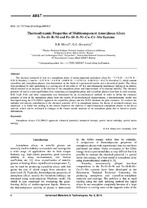| dc.contributor.author | Khina, B. B. | en |
| dc.contributor.author | Goranskiy, G. G. | en |
| dc.date.accessioned | 2021-01-21T12:15:38Z | |
| dc.date.available | 2021-01-21T12:15:38Z | |
| dc.date.issued | 2016 | ru |
| dc.identifier.citation | Khina, B. B. Thermodynamic properties of multicomponent amorphous alloys in Fe-Si-B-Ni and Fe-Si-B-Ni-Co-Cr-Mo systems = Термодинамические свойства многокомпонентных аморфных сплавов в системах Fe-Si-B-Ni и Fe-Si-B-Ni-Co-Cr-Mo / B. B. Khina, G. G. Goranskiy // Advanced Materials & Technologies. – 2016. – № 2. – P. 8-15. | en |
| dc.identifier.uri | https://rep.bntu.by/handle/data/83978 | en |
| dc.description.abstract | The chemical potential of iron in a amorphous phase of multicomponent multiphase alloys Fe - 7.3% Si - 14.2% B - 8.26% Ni (alloy 1) and Fe - 0.32% Si - 4.8% B - 6.68% Ni - 2.42% Co - 8.88% Cr - 6.42% Mo (alloy 2), which contain crystalline and amorphous phases, was determined on the basis of experimental results and a theoretical model. The alloys were produced by melt quenching at a cooling rate of the order of 105 K/s and subsequent mechanical milling in an attritor, which resulted in an increase in the fraction of the amorphous phase and improvement of its thermal stability. The chemical potential of iron in a non-equilibrium alloy containing an amorphous phase and crystalline phases (iron-base a-solid solution, FeB, Fe2B, FeSi and other compounds) was determined by an electrochemical method. In order to define the chemical potential of iron in the amorphous phase from the results of electrochemical measurements, a thermodynamic model was developed using the CALPHAD approach for crystalline phases and the SGTE database for pure elements. To evaluate the enthalpy and entropy contribution to the chemical potential of Fe in amorphous phases, the theory of mismatch entropy was employed. It is found that milling in the attritor improves the stability of multicomponent amorphous phases in the above systems, which can be attributed to changes in the cluster-atomic structure of an amorphous phase due to intensive plastic deformation. | ru |
| dc.language.iso | en | en |
| dc.title | Thermodynamic properties of multicomponent amorphous alloys in Fe-Si-B-Ni and Fe-Si-B-Ni-Co-Cr-Mo systems | en |
| dc.title.alternative | Термодинамические свойства многокомпонентных аморфных сплавов в системах Fe-Si-B-Ni и Fe-Si-B-Ni-Co-Cr-Mo | ru |
| dc.type | Article | en |
| local.description.annotation | Химический потенциал железа в аморфной фазе многокомпонентных сплавов Fe - 7,3 % Si - 14,2 % В - 8,26 % Ni (сплав 1) и Fe - 0,32 % Si - 4,8 % В - 6,68 % Ni - 2,42 % Со - 8,88 % Cr - 6.42 % Mo (сплав 2), которые содержат кристаллические и аморфные фазы, определяется на основе экспериментальных результатов и теоретической модели. Сплавы получены путем закаливания расплава со скоростью охлаждения порядка 105 K/с и последующего механического размалывания в мельнице тонкого помола, что приводит к увеличению доли аморфной фазы и улучшению ее термостойкости. Химический потенциал железа в неравновесном сплаве, содержащем аморфную и кристаллическую фазы (a-твердый раствор на основе железа, FeB, Fe2B, FeSi и другие соединения), определены электрохимическим методом. Для химического потенциала железа в аморфной фазе по результатам электрохимических измерений разработана термодинамическая модель с использованием подхода CALPHAD для кристаллических фаз и базы данных SGTE для чистых элементов. При оценке вклада энтальпии и энтропии в химический потенциал Fe в аморфных фазах использована теория несоответствия энтропии. Показано, что размалывание в мельнице улучшает устойчивость многокомпонентных аморфных фаз в указанных системах, что может быть вызвано изменениями в кластерной атомной структуре аморфной фазы вследствие интенсивной пластической деформации. | ru |

